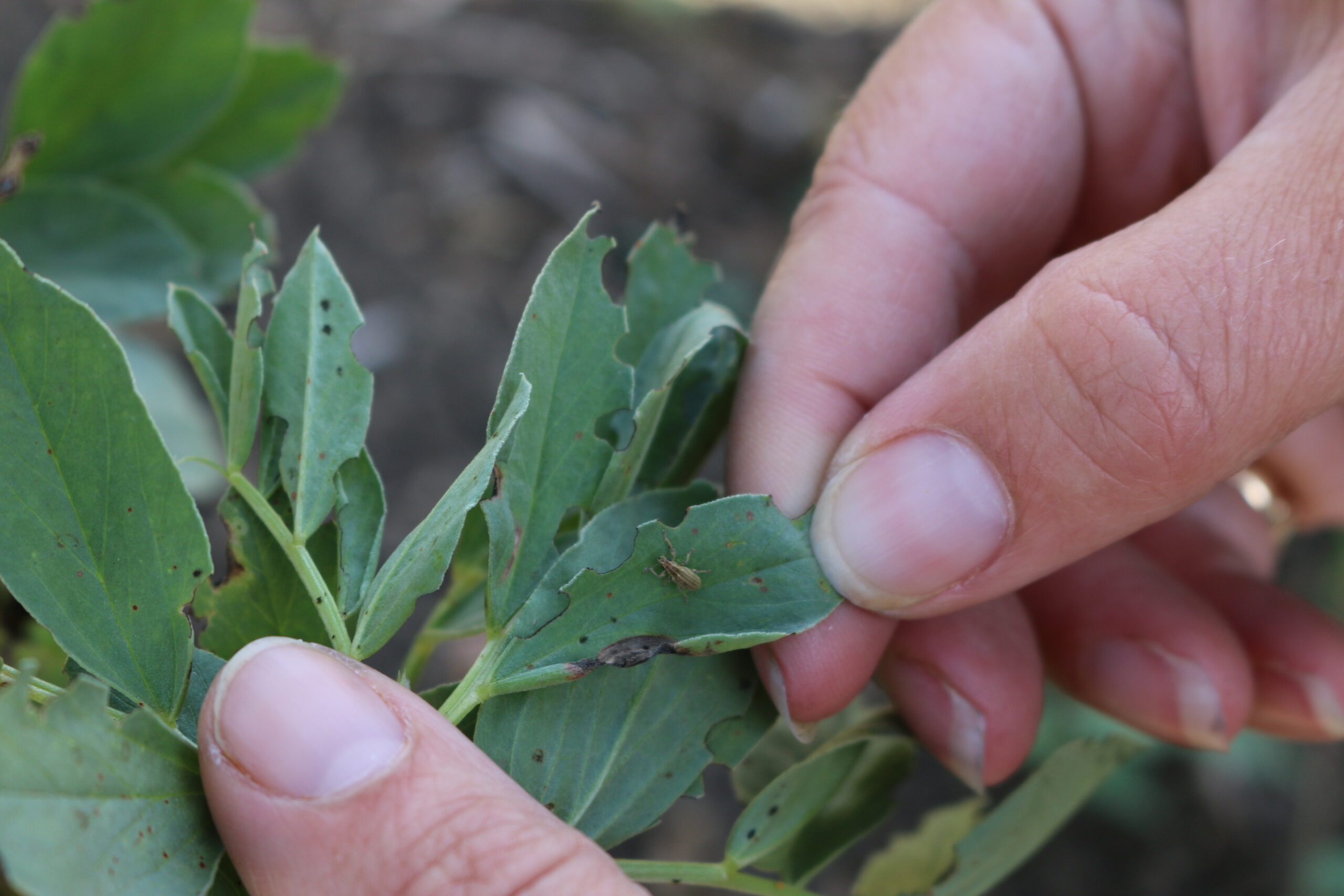By Bruce Barker, P.Ag.
Pollination is the first step in the process of sexual reproduction in plants. In pollination, a male pollen grain is transferred to the female part of a flower, germinates, and fertilizes the ovule. All of these steps must occur for a seed to develop. Pollination occurs either as self- pollination or cross-pollination.
In self-pollination, pollen from one flower pollinates the same flower or other flowers of the same plant. Therefore insects are not required to pollinate the crop. However, self-pollinating plants may still benefit from pollen vectors such as wind or insects. For example, soybeans are self-pollinating and the flowers are open and receptive of bee transfer of pollen during the daytime. If fertilization is not accomplished during the daytime, the plant self-pollinates as the flowers are closing at night.
Cross-pollinating plants require pollen to be moved between plants, by pollinators or wind, to fertilize the female part of the flower.
Faba Beans
Faba beans are a partially out-crossing species with cross-pollination reported to range from 4-84%. Out-crossing is entirely the result of insect cross-pollination.
Alberta Agriculture research in 2004 on zero-tannin faba beans at Devon, Alberta found that yields of plots open pollinated at five and 250 metres (m) from bee colonies increased by 47.14% and 29.33% respectively, compared to 500 m away. Honeybee activities in caged faba beans increased yield by 26.16%. In caged faba bean plots, average seed weight increased 11.27% and increased the number of seeds per plant by 11.65%.
A number of Australian studies indicate the presence of honeybees accelerates the rate of pod set. Plants with access to bees set more pods on the lower nodes and ripen earlier with significantly more seeds per pod. The use of honeybees has the potential to increase yields of faba beans by 19-52%. In one case honeybees doubled the yield.
The average benefit of honeybees on faba beans in South Australia was estimated to be an additional 17%, 90% attained within 767 m of hives. The economic analysis indicated that the addition of hives was profitable for a wide range of realistic values for crop value (dollars per tonne), and pollination cost (dollars per hive).
Information from the University of Guelph recommends a stocking rate of 2.5 honeybee colonies per hectare for faba beans. If native bee numbers are not high, the use of bees can significantly increase yield (by up to 40%). However, the use of a large number of hives could be unnecessary, as the plants will only set seed from a portion of their flowers and abort the rest no matter how many are pollinated.
Peas
Peas are self-pollinating. Very little cross-pollination occurs as the anthers release their pollen prior to the opening of the flower bud. Some pollinators will collect pea pollen, and pest infestations (ex. thrips) can also result in cross-pollination rates as high as 20%. There is some evidence that this can increase yield, but in general pea flowers are not designed for pollination by insects.
Lentils
Lentils are self-pollinating with cross-pollination at usually less than 1% with a maximum of 6.6% recorded.
Chickpeas
Chickpeas are a self-pollinated crop. Cross-pollination is rare, only 0- 1% is reported.
Dry Beans
While some bean species are capable of self-pollination, many produce a higher yield if insects are allowed access to the flowers. Hand pollination experiments suggest that this is at least partly due to increased cross-pollination.
Soybeans
Ontario Ministry of Agriculture information indicates that soybeans are considered to be a self-pollinating legume. Since soybean flowers do not readily attract insects like the flowers of other legumes, crosses in nature between two soybean plants are rare. Field experiments have shown that cross-pollination is usually less than 1% in soybeans.
In a study of 12 soybean cultivars in Arkansas where both honeybees and indigenous insect populations were present, cross-pollination varied from as low as 0.09% to as high as 1.63%, based on a two-year average. Therefore insects including honeybees are not required to pollinate soybeans and the presence of insects would not be expected to significantly improve yields.
Statistics Canada estimated the value of honeybee pollination in 2013 in soybeans in Canada at a relatively small $1.25 million.
Insecticides and Bee Safety
Help to reduce insecticide poisoning of pollinators, and other beneficial insects such as predatory and parasitic biological control insects. The Saskatchewan Ministry of Agriculture recommends:
- Avoid applying insecticides that are toxic to bees on crops in bloom
- Apply insecticides when bees are least active, generally in late evening or early morning when the bees are not foraging. As a general rule, evening applications are less hazardous to bees than morning applications
- Avoid insecticide drift
- Notifying the beekeeper in advance (ex. 48 hours) of applying insecticides will allow the beekeeper to move, or protect the colonies from insecticide damage
- If possible, use insecticides and/or insecticide formulations that are the least hazardous to bees



